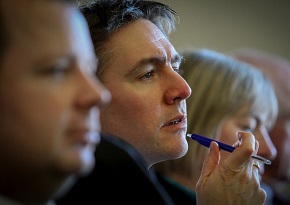Civil engineers shortage
Credible plans to address the shortage of civil engineers often seem to be focused on long-term sustained actions that won’t deliver now but several years in the future. Possibly. New research sponsored by ICE suggests CEOs and the sector are missing a trick that can be actioned now.
Contents |
[edit] Introduction
All of us, whatever our position or role within the infrastructure sector, are aware of the critical need for more civil engineers, now and in the future.
A large number and wide variety of long-term actions and projects are underway to change this. All are highly valuable and very much needed. We are proud to encourage and celebrate such projects.
However, new research suggests that CEOs and the infrastructure sector are missing an actionable trick that could start delivering real benefits in the competition for talent right now. So what’s the research and what does it show?
[edit] ICE sustainability survey
In the biggest survey of its type that ICE has conducted, UK based members were asked questions about sustainability. CEOs and senior staff may sigh heavily at this point - ‘sustainability is not my bag, not a commercial priority, not a technical priority, all a load of greenwash.’
We sympathise. But bear with us, this new data is particularly important for CEOs and senior staff. The engineers surveyed were at different stages of their careers, with both some common themes and differences between millennials and non-millennials.
Overall, the vast majority (87%) of engineers agreed that their projects should be delivering sustainable development goals. Just 34% of respondents felt that their firm had suitable measurement methods for projects, with millennials twice as likely than non-millennials to say that their firm’s scheme was not fit for purpose (36% vs 16%).
Consistent with this challenge, millennials were 15-20% more demanding of the overall need to drive improved measurement of SDG impacts on projects.
Take home message: for millennials, sustainability is a core part of professional aspirations, and they want to see change - fast, relevant, measurable – and they want to be part of the discussion.
[edit] Competing as a buyer in a seller’s market
So what, you may think. But given that there’s a major shortage of engineering talent, it’s a sellers’ market for talent, not a buyers’ one.
Engineers have the ability to choose the firms that best meet their professional aspirations, and avoid those that don’t. Employers don’t get a great deal of choice. Given the size of the shortage – 60,000 new engineers needed every year - competing for talent is a strategic priority for all engineering firms. As a strategic responsibility, it falls to CEOs and senior staff to address successfully.
Since working on projects that explicitly and actively deliver sustainability is a priority for the new generation of talent, existing senior talent needs to ensure that their projects and firms are explicitly and actively providing such projects. Lots of them.
Recognising this issue enables CEOs to see sustainability in a new light: not as tired or vague waffle but as a realistic source of competitive advantage in the competition for talent.
This is a key aspect that frequently gets overlooked in strategic discussions about sustainability.
[edit] Global issues, global opportunities and global networks
So how can this be done? Sustainability is a global matter, includes lots of issues and can be a very vague term remote from the shovel-ready focus of day-to-day engineering projects.
Two things will be particularly helpful in enabling CEOs and senior staff to exploit this competitive opportunity to recruit and retain talent.
Firstly, a greater understanding of the UN’s Sustainable Development Goals (SDGs) and how they can be applied to infrastructure projects.
Covering 17 different aspects of society, such as clean water and sanitation (SDG6), energy (SDG7), industry innovation and infrastructure (SDG9), sustainable cities and communities (SDG11) and life below water (SDG14), the SDGs set out development targets to be achieved by all nations by 2030.
These can be used within projects both within the UK and elsewhere to set design objectives and within firms to set strategic objectives.
Secondly, learning about thought-provoking example projects and firms that are already delivering sustainability, and sharing experiences with their peers from around the world.
This article was originally published here by ICE on 2 Aug 2018. It was written by Paul Mansell.
Mansell has 30 years’ experience in industry as a senior advisor on HS2, Post-Grenfell Buildings Safety Programme and more across nuclear, telco, transport and other sectors.
--The Institution of Civil Engineers
[edit] Related articles on Designing Buildings Wiki
- Articles by ICE on Designing Buildings Wiki.
- Civil engineer.
- Eight ways to win the fight for talent in construction.
- Engineering in the 21st century.
- How to become a civil engineer.
- Recruiting and retaining talent in the construction industry.
- Skills shortage.
- Tackling the construction skills shortage.
Featured articles and news
Shading for housing, a design guide
A look back at embedding a new culture of shading.
The Architectural Technology Awards
The AT Awards 2025 are open for entries!
ECA Blueprint for Electrification
The 'mosaic of interconnected challenges' and how to deliver the UK’s Transition to Clean Power.
Grenfell Tower Principal Contractor Award notice
Tower repair and maintenance contractor announced as demolition contractor.
Passivhaus social homes benefit from heat pump service
Sixteen new homes designed and built to achieve Passivhaus constructed in Dumfries & Galloway.
CABE Publishes Results of 2025 Building Control Survey
Concern over lack of understanding of how roles have changed since the introduction of the BSA 2022.
British Architectural Sculpture 1851-1951
A rich heritage of decorative and figurative sculpture. Book review.
A programme to tackle the lack of diversity.
Independent Building Control review panel
Five members of the newly established, Grenfell Tower Inquiry recommended, panel appointed.
Welsh Recharging Electrical Skills Charter progresses
ECA progressing on the ‘asks’ of the Recharging Electrical Skills Charter at the Senedd in Wales.
A brief history from 1890s to 2020s.
CIOB and CORBON combine forces
To elevate professional standards in Nigeria’s construction industry.
Amendment to the GB Energy Bill welcomed by ECA
Move prevents nationally-owned energy company from investing in solar panels produced by modern slavery.
Gregor Harvie argues that AI is state-sanctioned theft of IP.
Experimental AI housing target help for councils
Experimental AI could help councils meet housing targets by digitising records.
BSRIA Occupant Wellbeing survey BOW
Occupant satisfaction and wellbeing tool inc. physical environment, indoor facilities, functionality and accessibility.
























